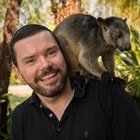Aussie megafauna depicted in new reconstructions

John Pickrell
John Pickrell

PETER TRUSLER IS one of Australia’s foremost palaeoillustrators and his representations of extinct Aussie creatures are superb. That’s why it’s always exciting to see what his latest project is.
Peter has created great little illustrations of extinct megafauna for a new series of silver coins for the Perth Mint. The coins feature some of the most interesting and iconic Australian giants, all of which became extinct more than 18,000 years ago.
A lot goes into creating the reconstructions, which start with the study of the fossilised bones. “It may take me six months to talk to the scientists, read the literature, visit the museums and pull all that work together to get an idea of what I should do in the final painting,” Peter says. “After that, it may only take me a month or two to do the actual painting.”
The five species featured on the coins are:
Procoptodon goliah
The largest of all kangaroos. This giant ‘short-faced’ species was more than 2m tall, and was a heavy-set animal that weighed in at 200kg. Imagine the thud when these guys hopped through the bush. Procoptodon had extremely mobile arms with long claws that it could use to reach up high into trees to pull down vegetation. According to the Australian Museum, Procoptodon would have co-existed with Aboriginal people for as long as 30,000 years. In NSW Aboriginal people continue to have stories about a long-armed aggressive kangaroo that fits the description of the species. These animals may have survived in some parts of Australia until around 18,000 years ago. (See part of a toe bone I photographed at the Willandra Lakes World Heritage Area here).
Diprotodon optatum
The largest of all known marsupials. Diprotodon was related to wombats, but was the size of a car, at 4m in length and nearly three tonnes in weight. It was widespread across Australia and co-existed with Aboriginal people until around 25,000 years ago. It’s still unclear whether hunting or changing climate (or both) sent it to extinction. Diprotodon was a grazer that preferred semi-arid plains and open woodlands; and it probably didn’t move in large herds, but in small family groups.

Genyornis newtoni
A giant flightless ‘thunderbird’ that was common across Australia until around 40,000 years ago. It’s often mistaken as a relative of the emu, but this 2m-tall, 240kg species, was really a kind of giant duck or goose. Eggshell fragments from Genyornis are common in sand dune deposits in inland Australia (I found some of this at Willandra too – see here). Find another of Peter’s great illustrations of Genyornis here on the Museum Victoria site.
Thylacoleo carnifex
The fabled marsupial lion, which was the largest known marsupial carnivore. Though it originally evolved from a herbivore more like a possum, it was an adept and powerful ambush predator with sharp claws and a powerful bite; it was about the size of a jaguar, and may have spent part of its time living and hunting in the trees. Thylacoleo had teeth unlike any other predator with small canines, enormous incisors and molars which would have acted like bolt cutters to slice through flesh and bone. Thylacoleo was first scientifically described by Richard Owen at the British Museum in 1859; Owen is most famous for having coined the term ‘dinosaur’ in 1841.

Megalania prisca
Megalania has a good claim to be the largest land lizard that has ever lived. It was related to the perentie goanna and the komodo dragon, but twice the size of a komodo, at 5.5m in length and up to 600kg in weight. Megalania was an ambush predator that lived in grasslands and open woodland and hunted large herbivores such as Diprotodon. It survived until 18,000 years ago so would certainly have presented a formidable threat to Australia’s first Aboriginal inhabitants.
Pictures of the coins are courtesy of the Perth Mint/Peter Trusler. Find more details about the coins and the work that went into creating them here on the mint’s web site.
You may have seen our recent Q&A with some of the world’s great palaeoartists – watch out for the Aussie version coming soon to this blog!
John Pickrell is the author of Flying Dinosaurs: How fearsome reptiles became birds, available June 2014. Follow him on Twitter @john_pickrell.

